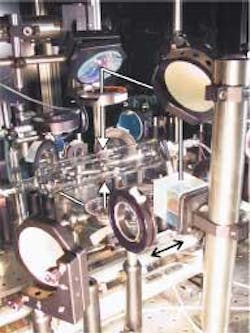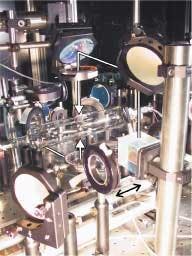Bose-Einstein 'cookbook' offers recipes for the nonspecialist
First created about seven years ago, Bose-Einstein condensates (BECs) have been studied extensively by specialists in atomic physics who have been most interested in the properties of the condensates themselves. But physicists in other fields, such as condensed matter, also have different and valuable perspectives on research that could be performed with BECs, according to researchers at JILA, a joint institute of the University of Colorado and the National Institute of Standards and Technology (Boulder, CO).1 Bose-Einstein condensates have been used to slow light (see Laser Focus World, April 1999, p. 16) and as a source for continuous-wave atom lasers (see Laser Focus World, July 2002, p. 32).
"The current experimental [BEC] systems were designed by people with a tremendous amount of knowledge and experience in experimental atomic physics, and until now producing a BEC without expertise in ultracold atom trapping has been a daunting task," according to Heather Lewandowski, lead author of a JILA paper describing how to consistently produce a stable BEC. "We felt, however, that with some modifications to current experimental design, and with a 'cookbook' set of instructions, any experimental physicist could produce a BEC in their lab."
Recipes in JILA's new BEC cookbook, based on original work by JILA scientists Eric Cornell (a co-author) and Carl Wieman, winners of the 2001 Nobel Prize in Physics for first achieving the BEC, describe traditional BEC-making methods as well as new features in a JILA-developed condensate design focused on creating functional condensates without necessarily optimizing them.
Key features in the JILA design that ensure consistent evaporation and condensate production include a magneto-optical trap (MOT) with sufficient laser power to collect a large quantity of atoms; a mechanical-transfer mechanism to efficiently and reliably transfer atoms from the atom collecting MOT to a second MOT for final cooling; and close proximity between the atoms and the magnetic-trapping magnets and coils for strong confinement and a high collision rate.
The track, motor, and controller for the mechanical-transfer system is actually commercially available as a turnkey system, which "is very easy to use," according to the cookbook, which also points out that the current JILA effort may just be the beginning of a trend: "Several groups around the world have recently unveiled novel condensate-producing technologies, and some of these may in the future prove simpler [than the JILA design] to implement." These include an atom-chip design consisting of a surface MOT, a magnetic trap on a wafer with lithographically patterned wires. Another all-optical method eliminates the need for a magnetic trap.
The detailed presentation of recipes in JILA's BEC cookbook begins with preparation of vacuum and optical systems; passes through precooling, transferring, and evaporative cooling of atoms to create a condensate; and continues through condensate imaging and extraction of useful parameters. Appendices focus on aspects such as working with rubidium and purchasing parts.
The estimated cost in 2002 dollars of building the experimental setup, which fits on a 122 × 244 × 30.5-cm optical table in the JILA laboratory, is $200,000 with an additional $75,000 for three lasers at three different wavelengths. Two of the lasers create the MOT, and the third laser images the condensate. All three lasers are locked to atomic transitions of rubidium 87 through saturated absorption spectroscopy (see figure). The estimate does not include cost of labor, presumably provided by graduate students and postdocs.
REFERENCE
- jilawww.colorado.edu/bec/BEC_for_everyone/

